—Understanding and tackling this invader with maintenance and technology solutions
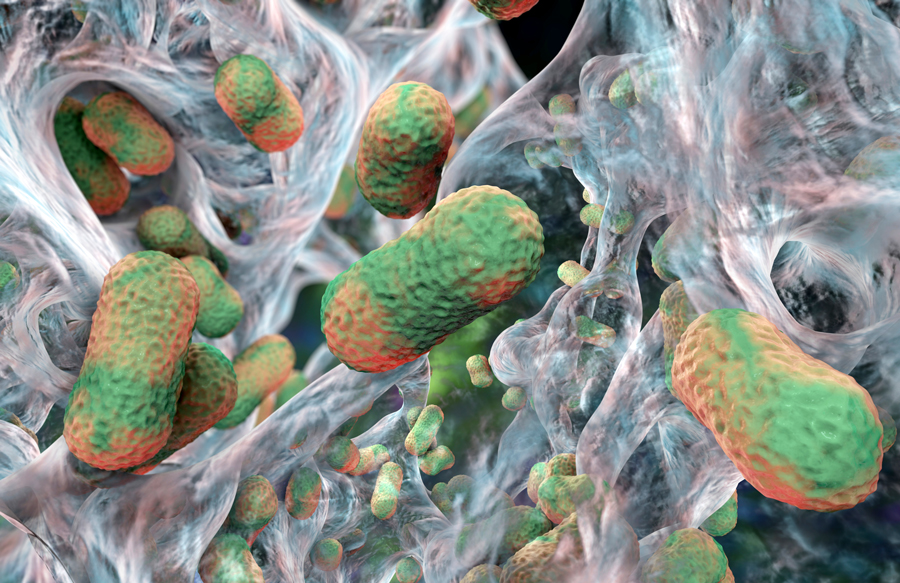
Just what is the icky, unwanted substance known as biofilm? In short, it’s a colony of microorganisms that builds up on wet surfaces.
What you may not realize: If you own a swimming pool or a spa, you have biofilm.For that matter, if you have a washing machine, dishwasher, garden hose, or a typical American home with plumbing, biofilm is already in your life.
According to scientists who study this nasty stuff, biofilm exists everywhere you have water and a surface— virtually without exception.
Biofilm is part of our world and has been since the beginning of life on our planet; it’s the living embodiment of primordial ooze.
In fact, the substance is so ubiquitous it even exists in our mouths. Yep, dental plaque is a form of biofilm. So is the awful coating on your tongue when you wake up each day—giving you morning breath.

As you sleep at night, there are unwanted microorganisms are setting up camp on your tongue and teeth, forming biofilm. Yuck.
Why are we so unaware of biofilm?
Most of the time, biofilm is microscopic. It comes in an imperceptibly thin coating that no one would ever notice, and it loves to hide inside pipes where it’s never seen.
Yet, we do often notice the much thicker, more visible versions. We see biofilm in the form of the scum that forms on drains or on pool tile or shower floors.
And, we certainly know how biofilm feels. Anytime you touch a slimy, slippery substance on a wet rock or a concrete surface—that too is almost certainly biofilm.
What the heck is inside it?
Fact is, even though biofilm is part of our daily lives—a kind of constant waterborne biological companion— most people don’t know—or want to know—what it actually is.
At most, we know it’s gross. Sometimes it smells foul and is decidedly unsavory. Sometimes, its presence is so upsetting it almost seems alive—and even sort of scary.
It’s because biofilm is very much alive, in a big way. It’s a colony of mold, fungi, bacteria, or protists (eukaryotic organisms) that form for their collective growth and survival.
Every biofilm is different, with infinite combinations of different kinds of minuscule creatures. Together they secrete polysaccharide substances.
In turn, the polysaccharides form a protective structure where these enterprising residents flourish, feeding on nutrients that float by.
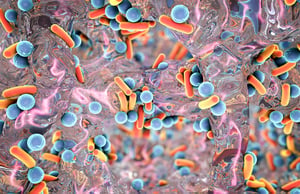
According to the Center for Biofilm Engineering at Montana State University, most biofilms contain up to 500 different microbial species!
A problem for swimming pools?
In a swimming pool or spa, no one wants biofilm. This sentiment is particularly true when the invader develops into the thick, goopy substance that coats pool pipes and visible surfaces such as pool tile.
When biofilm runs amok, it can become a maintenance nightmare. Along with calcium, the waterline scum on the tile perimeter is formed with biofilm.
In extreme cases, biofilm can grow so thick that it clogs pipes and impedes water flow—thereby compromising hydraulic efficiency and filtration.
Certain forms of algae blooms are a form of biofilm as well. The algae that grow on pool walls is a colony of microorganisms that have set up camp around the pool plaster.
It can also invade your pool’s cartridge filter. If you have ever removed a cartridge to clean it, you might have noticed a gooey, smelly layer covering the filter material. That’s biofilm.
Is biofilm a threat?
Perhaps the biggest concern about biofilm is whether or not it presents genuine health risks. Is it dangerous? Given that it’s composed of bacteria and other microorganisms, the natural assumption is yes.
The reality is more complicated. If all biofilm posed a threat, humans wouldn’t exist because we depend on water that doesn’t make us sick to survive.
The vast majority of life forms living in biofilm are actually benign co-inhabitants of the natural world.
However, there are bad actors. Hazardous pathogens will take up residence in biofilm and essentially lie in wait like a time-released biological weapon. When that happens, there is no question that biofilm can become a menace.
Disease-causing germs such as E. Coli, Giardia, and Legionella, among many others, will gladly develop in the welcoming colonies of biofilm. As we know, these microorganisms can make you sick; in the worst cases, they can even be fatal.
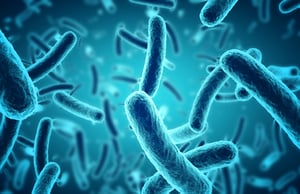
Some strains of Escherichia Coli, aka E. Coli, can lead to painful stomach cramps, vomiting, and bloody diarrhea.
From a pool-maintenance standpoint, here’s where things get interesting. So long as these pathogenic critters stay locked in the biofilm, they don’t harm us. The reason: They are not floating around freely in the water and coming into contact with swimmers.
But when these organisms become “planktonic”—a fancy word for free-floating—the story changes. They become a menace.
There are lots of reasons why biofilm will release its residents into the water. Changes in water chemistry, temperature, flow, pressure, or turbulence can all make biofilm slough off into your pool or hot tub.
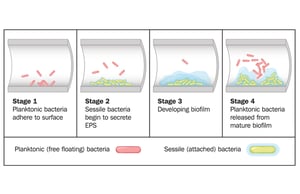
Biofilm is living and can move through cycles. If pathogens contained in stationary biofilm escape into pool or spa water, they may threaten swimmers.
Make no mistake, many cases exist where biofilm in water systems have become a serious issue.
The first documented outbreak of Legionnaire’s disease—a severe type of pneumonia—occurred in Philadelphia in 1976 among Legionnaires at a convention. The eruption sickened 211 victims, and ultimately killed 29. Investigators announced the likely culprit: biofilm in an air-conditioning unit.
What to do about biofilm in your pool?
That quirky hot tub problem aside, the good news is that for the most part, basic pool water testing and maintenance with water treatments will keep biofilm in check.
However, it is impossible to completely prevent or rid biofilm from any water system. Fortunately, by properly sanitizing a pool, the vast majority of bacteria potentially released from biofilm will be destroyed.
If you are relying on traditional tablet, powder, or liquid chlorine to keep your pool swim-ready, the recommended approach is to maintain chemical levels at 1 - 3 parts per million.
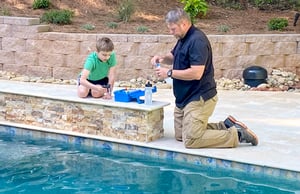
Regularly testing your pool water and maintaining proper chemistry is critical to ensuring a healthy swimming environment.
Likewise, regular cleaning routines such as brushing, vacuuming, scrubbing the tile line, and backwashing the filter will keep biofilm from becoming an aesthetic issue. More critically, these maintenance practices will minimize the negative impact on water quality.
Products designed to remove biofilm from plumbing are also available. Essentially, they are specialized degreasers that break down the biofilm structure.
While these products will indeed strip biofilm from pipes, some “elbow” grease is also required. You then have to remove the dislodged gunk from the water itself, either by vacuuming, draining, or filtering.
Battling biofilm with alternative sanitizer systems
Today, many savvy pool owners are turning to alternatives to the old-school chlorination approach.
Several technology options are available that dramatically cut reliance on harsh water treatments such as chlorine, clarifiers, shock, and algaecide.
The first comes in the form of alternative sanitizers. These systems operate with small amounts of chlorine to more effectively maintain the swimming environment.
Evidence exists to suggest the presence of ozone—a kind of triple-charged oxygen—will inhibit the development of biofilm.
Ozone is among the most powerful sanitizers and oxidizers used in modern pools and spas. It safely kills (sanitizes) free-floating pathogens, and it oxidizes (burns up) the compounds in water that feed germs and algae.

Ozone forms when a regular, two-atom molecule of oxygen (O2) combines with a single, free atom of oxygen. After a rainstorm, the fresh, sweet smell in the air is ozone.
You can produce ozone for your pool using a generator. A number of systems are available on the market.
To boost ozone’s effectiveness even further, you can opt for a model that adds in ultraviolet light—another powerful method against nasty microorganisms.
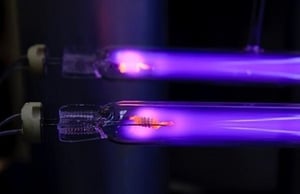
Ultraviolet light can tackle 99.9% of disease-causing microorganisms that form in swimming pools.
These dual UV/ozone systems deliver a double knock-out punch against an array of contaminants and slash the amount of chlorine that your pool needs.
Another available weapon takes the UV/ozone power couple a step further: By combining UV with ozone in a specific sequence—whereby the UV treats the ozone in an enclosed equipment chamber—you achieve the most powerful oxidizer of all: advanced oxidation process (AOP).
AOP produces hydroxyl radicals. They may sound scary, but they are safe, short-lived molecules that offer more pathogen-killing potential than chlorine, ozone, or UV with ozone.
By annihilating germs and their food supplies, hydroxyl radicals mitigate the possible consequences of biofilm

Remember: Pool or spa water can become dangerous if not properly sanitized with chlorine, bromine, ozone, UV, UV/ozone pairing, or AOP.
Specialized technology to impede biofilm growth
Two other weapons are available to supplement your anti-biofilm arsenal.
The first involves a key piece of pool equipment. Want to guard your pool filter against icky biofilm? Opt for a cartridge model that comes with built-in antimicrobial product protection to prevent heavy build-up.
This special integrated protection thwarts growth of various microbes. Better yet, the protection is enduring. Because it is embedded deep into the cartridge material fibers—versus a mere surface application—it does not leech out or lose its effectiveness.
You will appreciate how the pleats of material inside your pool cartridge will remain fresher between cleanings.

Tests proves how antimicrobial technology inhibits growth of bacteria, yeasts, molds, and fungi that cause stains, odors, and product degradation.
To make it even tougher for biofilm colonies to infest pool surfaces such as tile lines, cartridge filters, and plumbing lines, another cutting-edge approach is now available
Originally developed by the oil-drilling industry to treat toxins in wastewater—the newest technology safely reorganizes molecules of water into a state known as structured water.
Structured water is found in underground springs and the human body. It’s so safe that some health experts even advocate drinking it to boost wellness.
By using it in tandem with regular pool-water treatment, this specially energized water provides an extra layer of protection.
Structured water forms a kind of liquid barrier around a pool, helping repel all kinds of contaminant particles. The molecules gravitate outward to the pool’s waterline, and then group in a thin, invisible protective ring
With their route impeded, unwanted substances cannot stick to pool surfaces to form ugly, biofilm-laden scum lines.
That means the tile and stone surfaces stay cleaner. This safe, proven technology also makes pool water softer and sparkling clear.
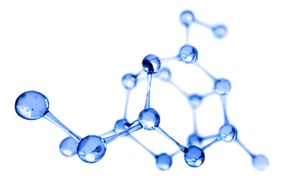
Molecules of structured water arrange into sheets of a hexagonal forms.
Living with biofilm
Whether we like the idea or not, the bottom line is that we all have to co-exist with biofilm.
In pools and spas, there’s no single magic bullet. But if you follow recommended water-treatment and cleaning guidelines, the odds are biofilm will remain only a minor and occasional annoyance.
For an extra shield to safeguard your pool, consider advanced sanitation systems such as ozone, ozone/UV, and AOP. Step it up even further with specialized technology such as an antimicrobial cartridge filters and a structured water system.




.jpg?width=1490&name=rock-waterfall-slide-pool%20(1).jpg)